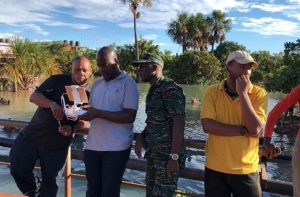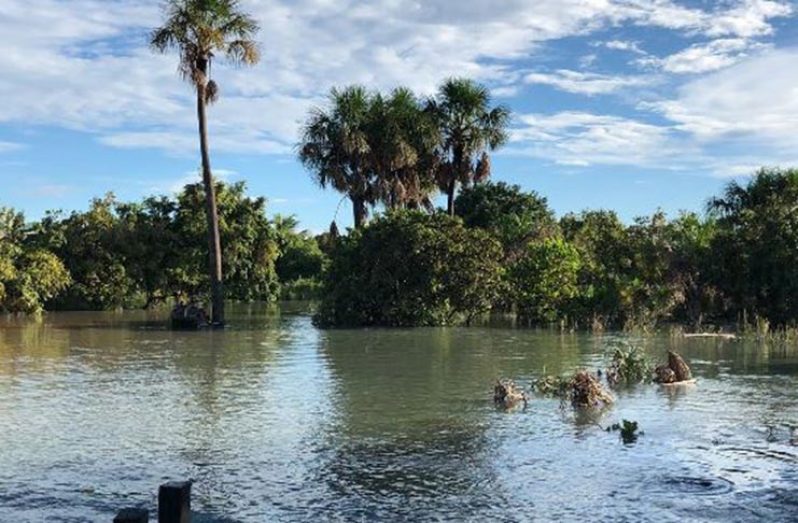– report to be presented to Cabinet
THE Civil Defence Commission (CDC) in collaboration with the Ministries of Public Health and Public Infrastructure and the Regional Democratic Council (RDC) of the Upper Takutu-Upper Essequibo (Region Nine) over the past two days, conducted a damage risk assessment in the region, primarily along Karasabai, South Pakaraimas and Aishalton, South Rupununi, with the aim of identifying the vulnerabilities and types of hazards to the communities, which are currently under flood watch.

The team, which is led by Director General of the CDC, Lieutenant Colonel Kester Craig first stopped at Karasabai to meet with village officials and to determine how the village and the surrounding communities have been affected. Deputy Toshao of the village, Mr. Andrew Albert Junior, in an invited comment, said that so far, only Karasabai and Tiger Pond in the South Pakaraimas have experienced a rise in the water levels. However, he noted that only one household had to be evacuated in Tiger Pond as the water had begun to enter the resident’s home. So far, Mr. Albert said that there has been no further report of flooding in homes or farms.
Deputy Toshao Albert noted that the main concern shared by the six villages and one satellite community in that area, is the fact that the flood waters on the main access road has resulted in a total cut-off for villagers. This has prevented access in and out of the village and to Lethem and Georgetown. “We have been in touch with the RDC to ask if they can provide an outboard engine for a boat for us to transport emergency cases, as well as the children who have to go to school because we have exams going on right now. The water is dropping slowly but it will take a lot of time again,” he said. The flooding, he said, is caused not only by the heavy rainfalls or the ‘wet’ season, but the water running off the mountains and from neighbouring Brazil.
Over at Aishalton, which along with six other communities have been cut-off by road to and from Lethem, Toshao Michael Thomas, in an invited comment, said that the community has been experiencing heavy rainfall for the past two weeks. As in the case of Karasabai, the main access road has been cut off. There has been no reported cases of water-borne or vector-borne diseases. At Lethem, Mayor of the town, Mr. Kerry Jarvis, said that Lethem and neighbouring Tabatinga experienced flooding. He noted that approximately 15 households have been affected, three of which had to be evacuated.
Meanwhile, the Director General said that the risk assessment focuses on all of the vulnerabilities, hazards and overall risks of the region. “The assessment will be able to say, for instance, that the areas that are high risk, what are the options to minimise risk, such as relocation and moving persons from locations of high risk to areas of low risks. So based on our documentation they will be able to have a baseline for decision making,” he said.
He noted that the report will be going to Cabinet for the Government to examine the immediate, intermediate and long-term types of interventions. Lieutenant Colonel Craig noted that based on the assessment conducted on the ground, the water levels of the Ireng and Takutu rivers are high and as such, many of the communities are threatened. Based on the visits conducted, he noted that there has been some areas identified for collaboration between the CDC and the RDC in an effort to continue to monitor the situation and respond as is required. “We are continuing to work closely with the RDC to come up with a needs list. What we have realised is that we have to have communication at all times with all of the communities in the event that the water level increases and we will be able to communicate to decide what level of supplies if any, they would need. We also need communication for the hospital and health facilities to ensure that they have maximum supplies to deal with any type of incident. The CDC will also work with the RDC to determine whether there are long-term needs for shelters and if there will be any need for supplies like beds, cots, food, cleaning supplies for those homes affected and so on,” he said.

Lieutenant Colonel Craig said that the region has done a commendable job thus far and continues to work to ensure that the risks and damages are greatly minimised. “The RDC has been taking the lead and they know what has to be done. As a matter of fact, they have been providing vehicles to evacuate people from their homes to the shelter so they are on tops of things and the region is working very closely. You have to respond together and definitely we are working closely and once we can support them then we would,” he said. With regard to health, there have been no major outbreaks. While there has been some reported cases of diarrhoea and flu in some of the communities; the health facilities are equipped to treat these cases. (Ministry of the Presidency)




.png)









